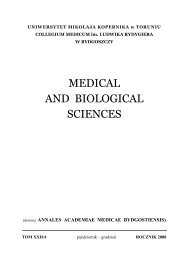Medical and Biological Sciences XXVI/2 - Collegium Medicum ...
Medical and Biological Sciences XXVI/2 - Collegium Medicum ...
Medical and Biological Sciences XXVI/2 - Collegium Medicum ...
You also want an ePaper? Increase the reach of your titles
YUMPU automatically turns print PDFs into web optimized ePapers that Google loves.
Intrarater repeatability of manual testing of first muscle movement resistance 29<br />
0,8<br />
0,7<br />
0,6<br />
0,5<br />
0,4<br />
0,3<br />
0,2<br />
0,1<br />
0<br />
Mean <strong>and</strong> maximal values for St<strong>and</strong>ard Error for measurement<br />
0,31<br />
0,55<br />
Ankle Flexion (º)<br />
0,33<br />
0,75<br />
Muscle lenght (mm)<br />
Mean SE<br />
Maximal SE<br />
Fig. 4. St<strong>and</strong>ard error for angular <strong>and</strong> linear movement –<br />
average <strong>and</strong> maximal values<br />
Another possibility of evaluation of the<br />
examination method is st<strong>and</strong>ard error of mean. In this<br />
case, because every test was conducted on different<br />
sample, each could have had a different actual result,<br />
there was no possibility to calculate st<strong>and</strong>ard error of<br />
mean (SE) for whole methodology of measurement. So<br />
in this paper, st<strong>and</strong>ard error was assessed for every test<br />
separately, <strong>and</strong> then average <strong>and</strong> maximal outcome has<br />
been calculated. These results of SE for both linear <strong>and</strong><br />
angular measurement are shown in Fig. 4.<br />
It must be noted that results observed in Fig. 4,<br />
actually very good, far below one millimeter <strong>and</strong> one<br />
degree respectively for linear <strong>and</strong> angular movement,<br />
could be considered only in discussion about<br />
repeatability, not accuracy. The reason is the fact that<br />
actual true values of spatial position of ankle or muscle<br />
length while first mechanical resistance occurs were<br />
unknown.<br />
DISCUSSION<br />
Manual testing of the muscles <strong>and</strong> joints is<br />
considered as a major skill in testing <strong>and</strong> treating<br />
musculoskeletal patients in many methods of manual<br />
therapy [3, 5, 10, 12]. Ability to feel <strong>and</strong> differentiate<br />
quality of movement, especially from its first<br />
resistance to the end of passive range of movement is<br />
considered crucial for testing in manual therapy [1, 2,<br />
11]. In fact, this is what makes the difference between<br />
manual therapy <strong>and</strong> physiotherapy in general.<br />
Supporting the idea, the general assumption is made<br />
that a therapist is able to gain ability to feel in recurrent<br />
manner both first mechanical resistance <strong>and</strong> quality of<br />
changes in elasticity of the movement. It is called end<br />
feel or joint play examination, respectively for<br />
physiological <strong>and</strong> additional movements [1, 3, 11].<br />
Nevertheless, there is visible lack of research works<br />
that confirm or deny that possibility among manual<br />
therapist. One of the reason of the small amount of<br />
research works in that subject is that described<br />
phenomenon itself is very subtle <strong>and</strong> dependent on<br />
many factors. It is very hard to assess in objective<br />
manner when this first mechanical resistance occurs in<br />
a living human being. Theoretically, first mechanical<br />
resistance (or tissue resistance) of muscle occurs when<br />
during passive movement myofibrils, fascia, tendon<br />
<strong>and</strong> other part of muscle as a whole, reach its resting<br />
length [8, 13, 14]. It is the moment from which<br />
stretching of the muscle-tendon unit could occur. So,<br />
physically, from that moment force needed to increase<br />
muscle length <strong>and</strong> range of movement rises, dependent<br />
on parameter called muscle stiffness [13, 18]. But it is<br />
not easy to perform objective evaluation of that<br />
moment on a living person, due to both technical<br />
problems <strong>and</strong> great amount of factors influencing that<br />
parameter. One of the technical problems is that<br />
passive movement does not produce electric activity of<br />
the muscles, so EMG is not valid for such examination<br />
[13, 18].<br />
The moment in which first resistance occurs is<br />
dependent mainly on muscle tonus, so the first group<br />
of factors influencing tissue resistance are<br />
neurophysiologic factors, such as mood, emotions,<br />
apprehension or reliance to therapist, but also spatial<br />
position of other part of the body causing stress to the<br />
nervous system – i.e. rotation in cervical spine<br />
[2,8,10,19,20].<br />
Other group of influencing factors is of mechanical<br />
nature. The most prominent in this group seems to be<br />
velocity of movement <strong>and</strong> number of repetition –<br />
especially if a test movement exceeds moment of first<br />
resistance [13, 14]. The importance of velocity is<br />
associated with viscoelasticity, mechanical<br />
characteristic of human soft tissues that is responsible<br />
for different reactions of forces acting with different<br />
speed, but also with physiologic protective reaction of<br />
a muscle [8, 13, 18]. The high amount of repetition<br />
could lead to a change of mechanical characteristic of<br />
the muscles, moving point of first resistance further in<br />
the range of movement [8, 10, 13]<br />
Third group of factors could be named technical.<br />
Inappropriate, uncomfortable position of both patient<br />
<strong>and</strong> therapist could affect both muscle tonus <strong>and</strong> make<br />
patient relaxation impossible. We also must not forget<br />
that movement in which tissue resistance is assessed<br />
must be passive. In clinical test, it is impossible to

















